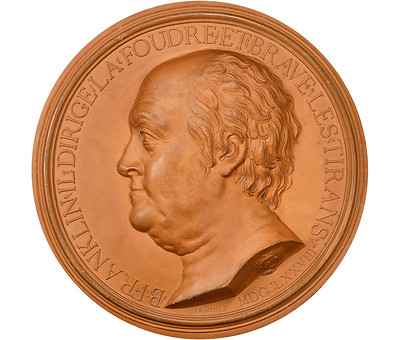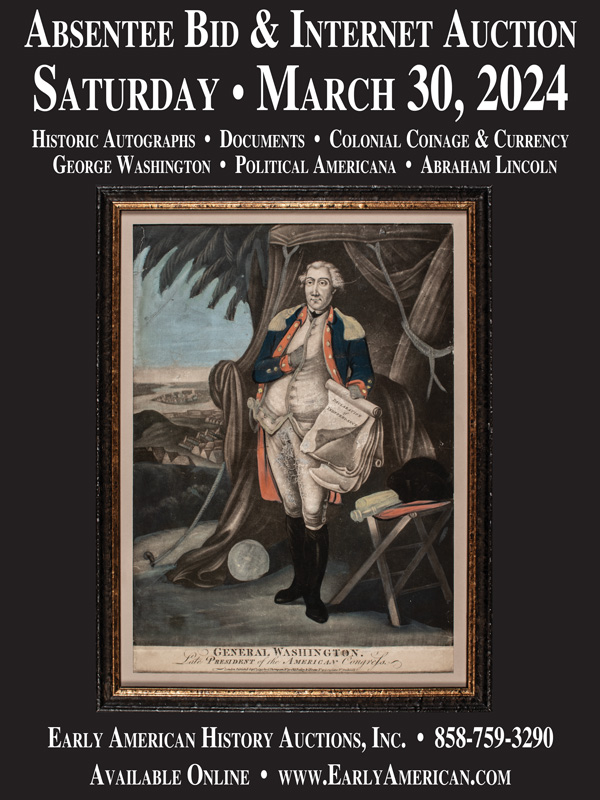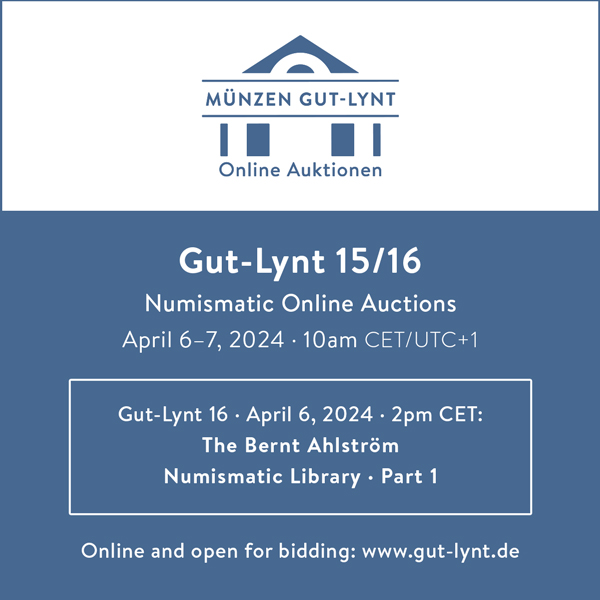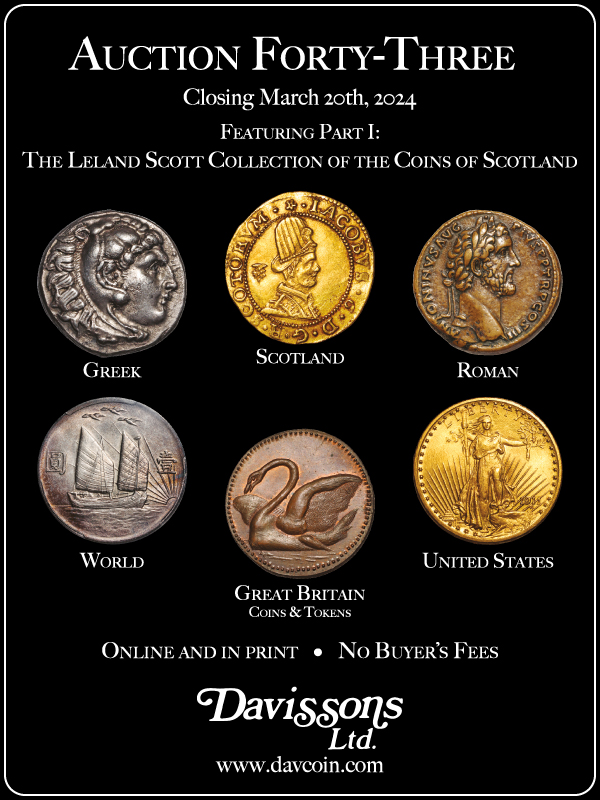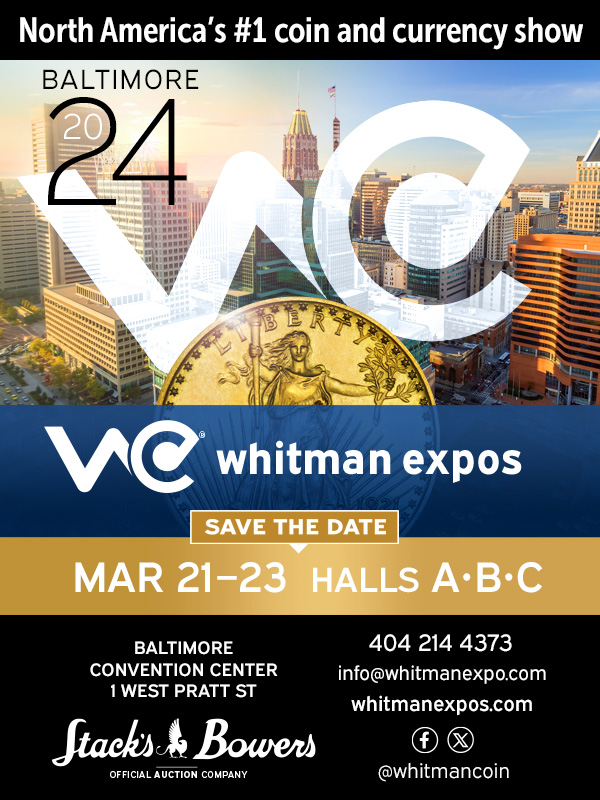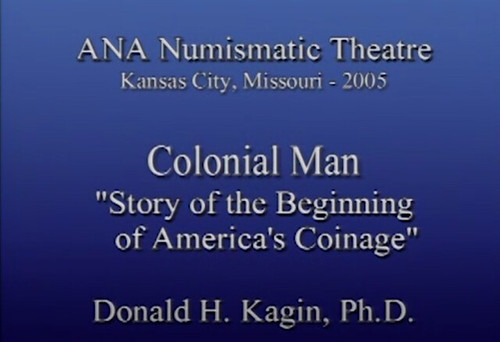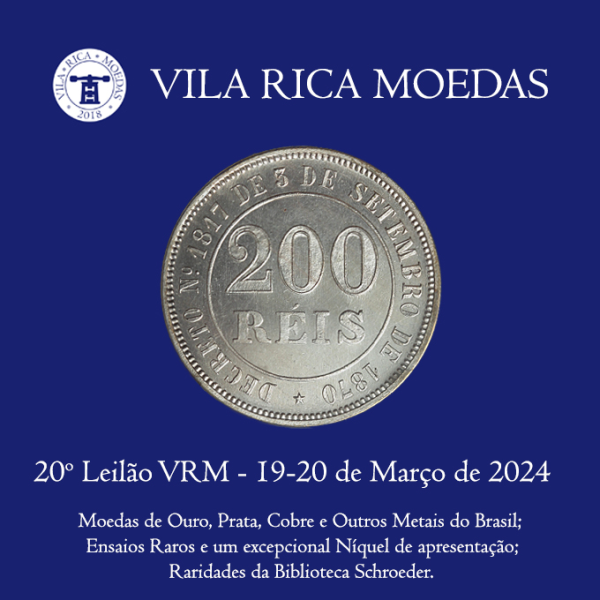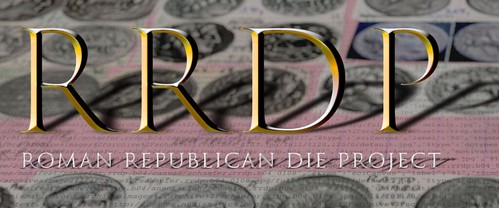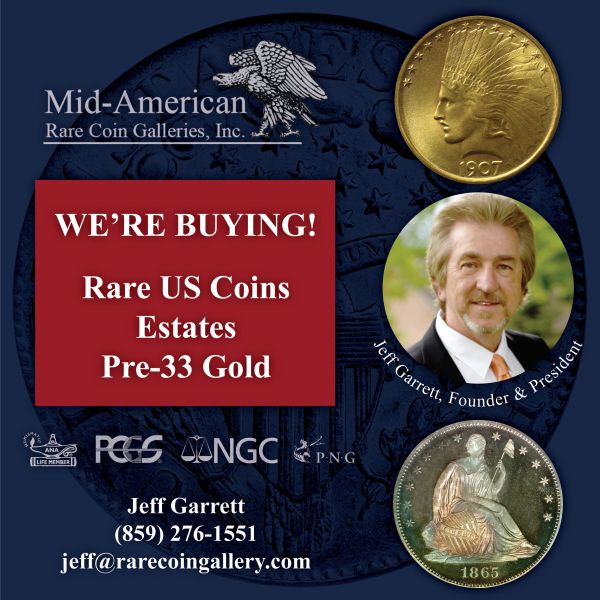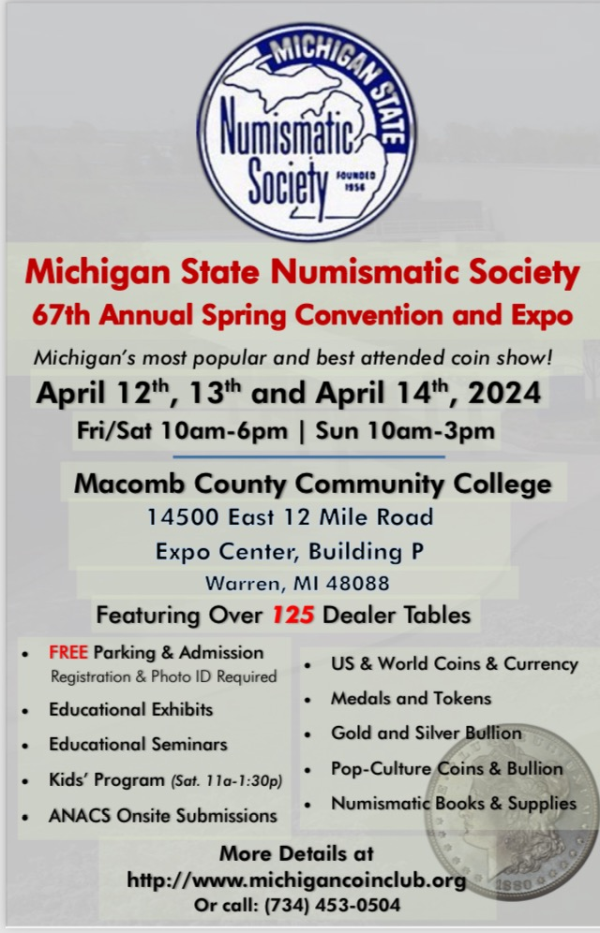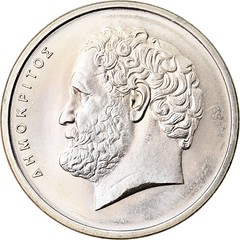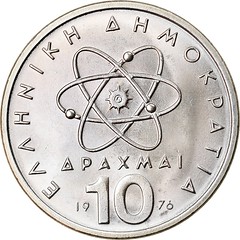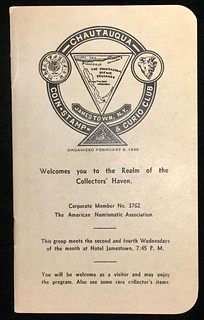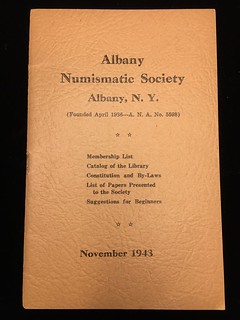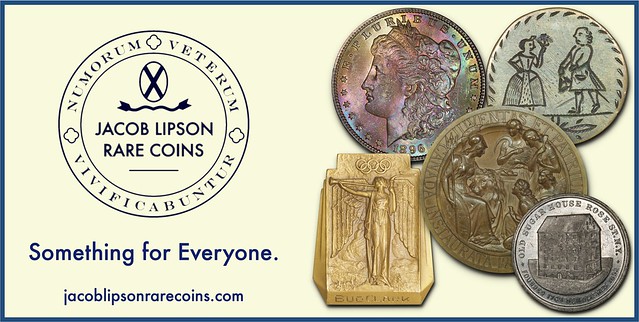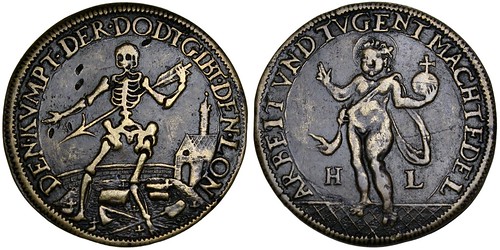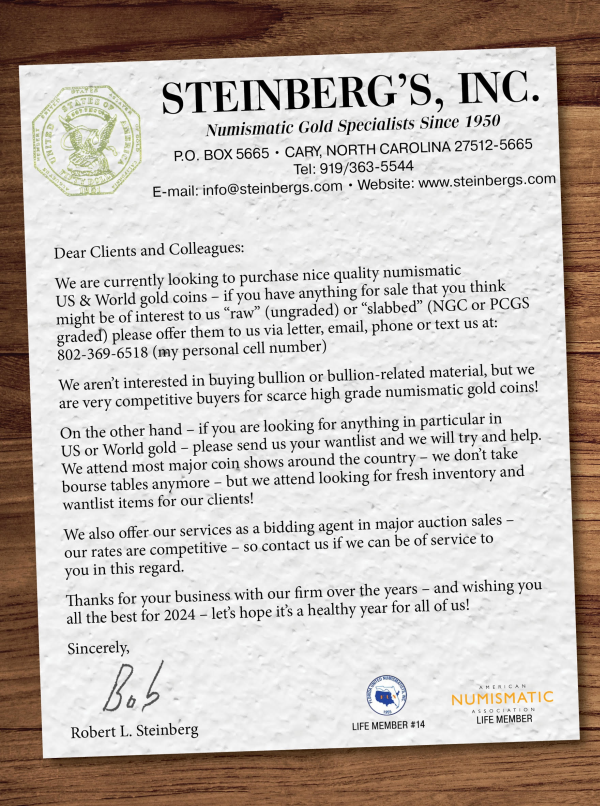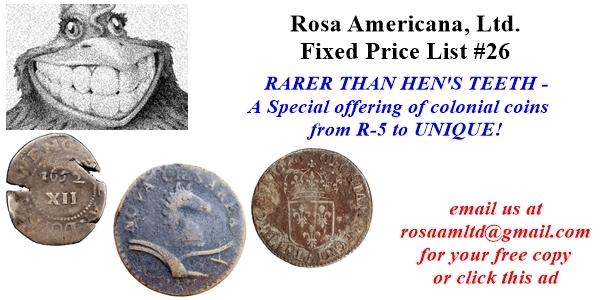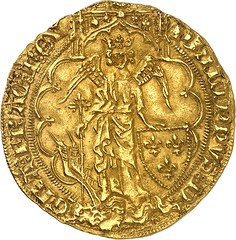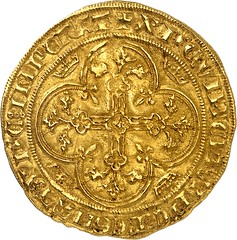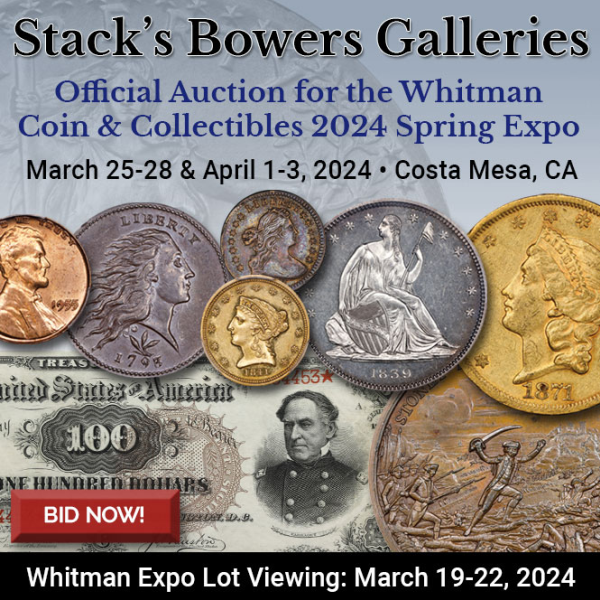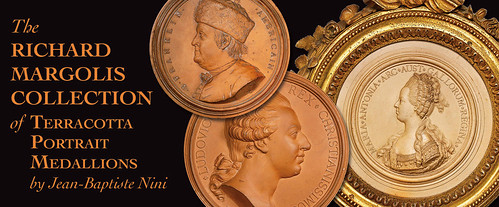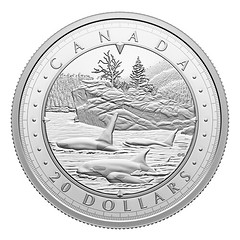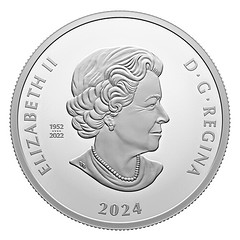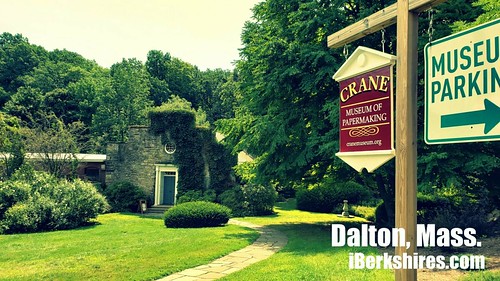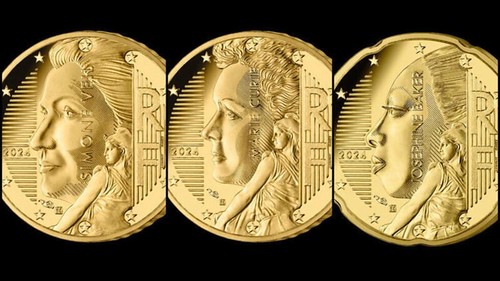
Visit our NBS Sponsors




About UsThe Numismatic Bibliomania Society is a non-profit association devoted to the study and enjoyment of numismatic literature. For more information please see our web site at coinbooks.org SubscriptionsThose wishing to become new E-Sylum subscribers (or wishing to Unsubscribe) can go to the following web page link MembershipThere is a membership application available on the web site Membership Application To join, print the application and return it with your check to the address printed on the application. Print/Digital membership is $40 to addresses in the U.S., and $60 elsewhere. A digital-only membership is available for $25. For those without web access, write to: Jeff Dickerson, Treasurer AsylumFor Asylum mailing address changes and other membership questions, contact Jeff at this email address: treasurer@coinbooks.org SubmissionsTo submit items for publication in The E-Sylum, write to the Editor at this address: whomren@gmail.com BUY THE BOOK BEFORE THE COINSale CalendarWatch here for updates! |
- WAYNE'S WORDS: THE E-SYLUM MARCH 17, 2024
- BERNT AHLSTROM NUMISMATIC LIBRARY, PART 1
- ERIC NEWMAN PAPER MONEY CORRESPONDENCE
- CHERRYPICKERS' GUIDE SECOND PRINT RUN ARRIVES
- NEW BOOK: CAMEO AND BRILLIANT PROOF COINAGE
- NEW BOOK: CROATIAN COINS AND BANKNOTES
- NEW BOOK: MONETARY BAMBOOS OF SUZHOU (1875-1949)
- NEW BOOK: HUNDIS IN PRINCELY STATES OF INDIA
- MAY 2024 NNP SYMPOSIUM ANNOUNCED
- NEWMAN ON THE 1913 LIBERTY NICKEL
- VIDEO: DONALD KAGIN AS COLONIAL MAN
- ROMAN REPUBLICAN DIE PROJECT UPDATE
- ON THE STATE OF STAMP COLLECTING
- NOTES FROM E-SYLUM READERS: MARCH 17, 2024
- SCOTT MILLER’S COIN CLUB BOOKLETS
- VOCABULARY TERM: PEWTER
- PETER MOUGEY (1842-1908)
- 2023 CHICAGO COIN CLUB HALL OF FAME
- WHAT KIND OF COLLECTOR ARE YOU?
- NUMISMAGRAM MEDAL SELECTIONS: MARCH 17, 2024
- VILA RICA MOEDAS AUCTION 20
- DAVISSONS AUCTION 43 SCOTLAND HIGHLIGHTS
- NOTES ON SCOTTISH COIN DESIGN
- KUENKER AUCTIONS 403-405
- KUENKER AUCTION 406
- STACKS BOWERS OFFERS NINI TERRACOTTA PORTRAITS
- VANCOUVER ISLAND GLEN GREEN'S ORCA COIN
- REPLICA PINE TREE SHILLINGS AT CSNS
- 2024 ANIMALS IN WAR & PEACE CEREMONY
- CRANE MUSEUM PAUSES LOCATION SEARCH
- LOOSE CHANGE: MARCH 17, 2024
Content presented in The E-Sylum is not necessarily researched or independently fact-checked, and views expressed do not necessarily represent those of the Numismatic Bibliomania Society.
WAYNE'S WORDS: THE E-SYLUM MARCH 17, 2024
 New subscribers this week include:
Nick Economopoulos.
Welcome aboard! We now have 7,308 subscribers.
New subscribers this week include:
Nick Economopoulos.
Welcome aboard! We now have 7,308 subscribers.
Thank you for reading The E-Sylum. If you enjoy it, please send me the email addresses of friends you think may enjoy it as well and I'll send them a subscription. Contact me at whomren@gmail.com anytime regarding your subscription, or questions, comments or suggestions about our content.
This week we open with two numismatic literature sales, five new books, updates from the Newman Numismatic Portal, notes and submissions from readers, and more.
Other topics this week include Croation coins and banknotes, Hundi scrip, the 1913 Liberty Nickel, the state of stamp collecting, fixed price and auction previews, Scottish coin design, replica Pine Tree Shillings, Nini terracotta portraits, Animals in War and Peace medals, and the Crane papermaking museum.
To learn more about Bernt Ahlström, the Cherrypickers’ Guide, the bamboo money of Suzhou, the next NNP Symposium, the Roman Republican Die Project, pewter, chemistry on coins, coin club literature, Peter Mougey, Professor R. Edward Davis, the Mond Nickel Company, Brazilian Gold Bars, and France's Josephine Baker coin, read on. Have a great week, everyone!
Wayne Homren
Editor, The E-Sylum
BERNT AHLSTROM NUMISMATIC LIBRARY, PART 1
Online Auction 16 from Münzen Gut-Lynt offers the first part of the numismatic library of dealer Bernt Ahlström. Here's the press release, which opens with a remembrance by Arne Kirsch. -Editor
The Bernt Ahlström Numismatic Library, pt. 1
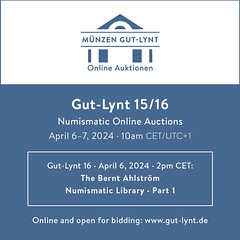 The Online Auction House Münzen Gut-Lynt is pleased to offer on the opening day of the Gut-Lynt auction weekend from April 6 to 7, 2024 (encompassing Gut-Lynt 15, Coins and Medals, and Gut-Lynt 16, Numismatic Literature) the first part of the numismatic library of an equally illustrious and interesting numismatic "global player" as well as comprehensive connoisseur.
The Online Auction House Münzen Gut-Lynt is pleased to offer on the opening day of the Gut-Lynt auction weekend from April 6 to 7, 2024 (encompassing Gut-Lynt 15, Coins and Medals, and Gut-Lynt 16, Numismatic Literature) the first part of the numismatic library of an equally illustrious and interesting numismatic "global player" as well as comprehensive connoisseur.
About Bernt Ahlström, 1936–2019 (Author: Arne Kirsch, numismatist of the SINCONA Group, Honorary President of the IAPN)
You will hardly find a dealer in the numismatic world who is completely unfamiliar with the name Bernt Ahlström. When I picked up my first coins as well as books on coins and medals in Schleswig-Holstein in 1978, he was already a regular guest in the far north of Germany, bringing both consignments and stories with him.
ERIC NEWMAN PAPER MONEY CORRESPONDENCE
The Heritage auction of researcher Eric P. Newman's correspondence files is a great opportunity for researchers and bibliophiles. Here are additional highlights submitted by Bruce Hagen and Maureen Levine. Thanks! -Editor
Selections from the Eric P. Newman Correspondence Files
Closing Soon
Eric P. Newman’s fascination with paper money led to a lifetime of scholarly research and prolific writing on the subject. His correspondence files are now offered unreserved in Heritage’s Showcase Auction #63247, closing Monday March 25, 2024, at 7:00 P.M. CDT. Decades of documents include letters between Eric and other legendary currency specialists from “A” to Wismer. Many of the lots contain priceless artifacts that will open avenues for further study and enjoyment.
Below are some “vignettes” that will provide intriguing insights into Eric’s perspectives on paper money:
CHERRYPICKERS' GUIDE SECOND PRINT RUN ARRIVES
Whitman Publishing reported a sellout of the first printing of the new sixth edition, volume II, Cherrypickers' Guide to Rare Die Varieties, prompting a second print run, which is now available. Here's the press release -Editor
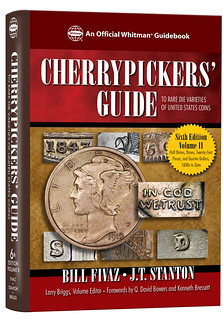 Whitman® announces the release of a second print run of the Cherrypickers’ Guide to
Rare Die Varieties: Volume II, 6th Edition. The wait is finally over for this highly anticipated reference, which
originally debuted at last year’s ANA World’s Fair of Money in Pittsburgh.
Whitman® announces the release of a second print run of the Cherrypickers’ Guide to
Rare Die Varieties: Volume II, 6th Edition. The wait is finally over for this highly anticipated reference, which
originally debuted at last year’s ANA World’s Fair of Money in Pittsburgh.
“The Cherrypickers’ Guide was one of our best book sellers of the entire year,” said Whitman vice president of sales Dawn Burbank. When it released at the show, “collectors and dealers bought every advance copy we had. We couldn’t keep them on the shelves, and overall, we sold the entire print run of over 7,200 copies in just under four months.” Burbank added, “We expect the second print run to sell just as fast, based on pent-up demand for the wildly popular title.”
The 320-page spiralbound-hardcover Cherrypickers’ Guide can be ordered for $39.95 online now at whitman.com, Whitman’s Ebay Store, Amazon, and will be available in bookstores, hobby shops, and other online retailers nationwide later this month. Ask your favorite coin dealer for a copy!
NEW BOOK: CAMEO AND BRILLIANT PROOF COINAGE
A revised edition of Rick Tomaska's book “Cameo and Brilliant Proof Coinage of the 1950 to 1970 Era” is being published. Here's the announcement. -Editor
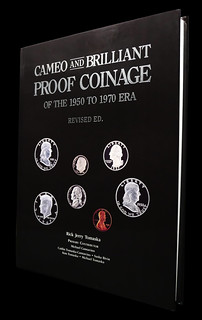 The long-awaited revised edition of my 1991 book “Cameo and Brilliant Proof Coinage of the 1950 to 1970 Era” is coming through our doors any day now!
The original Cameo book was a groundbreaking addition to numismatic collectors- new and veteran collectors alike. Rick Montgomery, former President of PCGS and the current President of NGC, wrote a truly fantastic foreword for this revision:
The long-awaited revised edition of my 1991 book “Cameo and Brilliant Proof Coinage of the 1950 to 1970 Era” is coming through our doors any day now!
The original Cameo book was a groundbreaking addition to numismatic collectors- new and veteran collectors alike. Rick Montgomery, former President of PCGS and the current President of NGC, wrote a truly fantastic foreword for this revision:
There is no one more closely associated U.S. cameo proof coinage than Rick Tomaska. No one even close. When the first edition of Cameo and Brilliant Proof Coinage of the 1950 to 1970 Era was published in 1991, it was clear that Rick was ahead of his time. Although these coins were comparatively recent issues, Rick recognized that a world of difference could exist between any two examples. For example, on 1967 Special Mint Set Kennedy half dollar might be uncommonly rich, thickly frosty, almost jewellike, while another could be comparatively flat and pedestrian. No one else, it seemed, understood the significance of these differences.
Starting from a framework of knowledge he had garnered as a dealer specializing in Prooflike and Deep Prooflike Morgan dollars, he began to explore this more-modern coinage. He approached it technically, learning about the minting process, techniques, and die life. That explained, to Rick, why these coins existed in the first place and why they existed in varying degrees of quality. At the same time, as a market-maker of cameo proof coinage, he learned precisely what was uncommon, what was scarce, and what was truly rare. His keen eye allowed him to differentiate one coin from another that, although similar, had vastly different market values. All of this research led to the first edition of this book.
NEW BOOK: CROATIAN COINS AND BANKNOTES
Here's a Google-translated article by Hans Ludwig Grabowski discussing a new book on Croatian coins and banknotes. -Editor
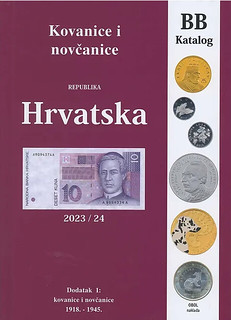 Borna Barac: Kovanice and Novcanice Republika Hrvatska 2023/24, Dodatak 1: Kovanice and Novcanice 1918 – 1945.
Borna Barac: Kovanice and Novcanice Republika Hrvatska 2023/24, Dodatak 1: Kovanice and Novcanice 1918 – 1945.
(Coins and banknotes of the Republic of Croatia 2023/24, Appendix 1: Coins and banknotes 1918 – 1945).
192 pages, hardcover, color illustrations throughout, format 17 cm x 24 cm, Zagreb 2024.
Price: 20.00 euros.
ISBN: 978-953-6388-18-9
NEW BOOK: MONETARY BAMBOOS OF SUZHOU (1875-1949)
Craig Greenbaum and John Madlon kindly responded to Ted Puls' inquiry about F. Thierry's book on Chinese bamboo money. It turns out the title is Les Bambous Monétaires de Suzhou (1875-1949) and it's available for sale on the site linked below. Thanks, everyone! -Editor
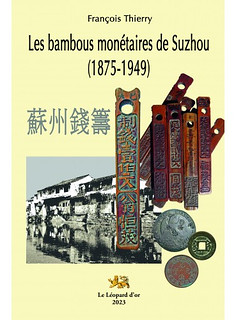 The Monetary Bamboos of Suzhou (1875-1949)
The Monetary Bamboos of Suzhou (1875-1949)
By: François Thierry
We know, since Marco Polo, that the Chinese invented paper money, but we know less that they also used other supports for money, such as fabric, wood, rubber and bamboo. Bamboo coins mainly circulated in the lower Blue River valley at the end of the Empire and the beginning of the Republic, and particularly in the Suzhou region in Jiangsu province. Until now, these bamboo coins had hardly attracted the attention of historians and numismatists, even in China where there is little work on the subject.
This work, the first in a Western language devoted to these objects and their history, therefore fills a void: it is a synthesis which reveals the circumstances of their appearance and the reasons for their success, explains the monetary system in which they are inserted, describes the environment of traders and entrepreneurs who issued them, and studies the different types. Accompanied by a rich, largely unpublished iconography, this book studies in detail more than 350 monetary bamboos preserved in public and private collections in Europe and China and thus immerses the reader in the daily life of a Chinese province.
NEW BOOK: HUNDIS IN PRINCELY STATES OF INDIA
Anil Bohora has published a new volume of his catalog detailing the Hundis scrip notes of India. -Editor
Anil writes:
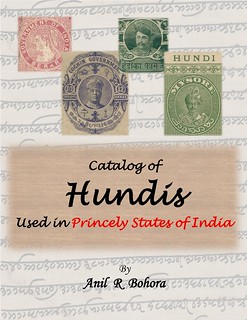 "I have just published the second volume of a catalog related to Hundis titled "Catalog of Hundis Used in Princely States of India".
"I have just published the second volume of a catalog related to Hundis titled "Catalog of Hundis Used in Princely States of India".
This book focuses on Hundis, which were a form of scrip used in India for quite a long time, used in princely states of India.
A4 Size. 408 Color Pages. Printed on Art Paper.
Price: US$60 + Shipping from India US$25
The book can be purchased by sending an email to bohoraa@yahoo.com."
MAY 2024 NNP SYMPOSIUM ANNOUNCED
The NNP Symposia are highlights of the numismatic year, bringing great speakers direct to you via Zoom. Be sure to plan for the next one. Here's the announcement. -Editor
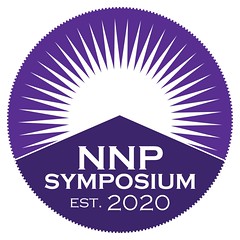 The Newman Numismatic Portal today announces the next NNP Symposium, which
will take place May 2-4, in conjunction with the Central States Numismatic Society convention in
Schaumburg, IL. Sessions will be available to in-person show attendees and will be livestreamed for
those wishing to view remotely.
The Newman Numismatic Portal today announces the next NNP Symposium, which
will take place May 2-4, in conjunction with the Central States Numismatic Society convention in
Schaumburg, IL. Sessions will be available to in-person show attendees and will be livestreamed for
those wishing to view remotely.
The NNP Symposium is a free event that brings together a variety of numismatic speakers and covers a wide array of numismatic subjects. Featuring approximately twenty presentations, attendees will easily note topics of interest. This is the eighth such event, which was launched by the Eric P. Newman Numismatic Education Society in fall 2020 in response to the pandemic.
NEWMAN ON THE 1913 LIBERTY NICKEL
Newman Numismatic Portal Project Coordinator Len Augsburger provided the following report. Thanks. -Editor
The Eric P. Newman Files on the 1913 Liberty Nickel
The story of Eric P. Newman’s acquisition of the five 1913 Liberty nickels from the estate of Colonel E.H.R. Green is the stuff of legend, and Newman’s extensive paper trail on this iconic coin is now offered for sale through Heritage Auctions. Presented as lot 52032 in Selections from the Eric P. Newman Correspondence Files, the files reveal Newman playing detective and working toward a presentation similar to his 1962 publication The Fantastic 1804 Dollar. Newman pursued multiple research topics, not all of which were published, and this file represents a project that did not reach fruition. Still, Newman’s status as owner of all five known examples (jointly, with Burdette G. Johnson) lends a unique perspective to perhaps the most famous of all American rarities.
VIDEO: DONALD KAGIN AS COLONIAL MAN
The David Lisot Video Library on the Newman Numismatic Portal can be found at:
https://nnp.wustl.edu/library/multimediadetail/522852
We highlight one of his videos each week in The E-Sylum. Here's one from 2005 with Don Kagin performing as "Colonial Man." -Editor
ROMAN REPUBLICAN DIE PROJECT UPDATE
The Roman Republican Die Project (RRDP) has added another batch of coin listings. -Editor
Another batch of Roman republican coin types has just been released to the Roman Republican Die Project (RRDP). The new release significantly expands the time period of issues that have been processed, since it includes early republican didrachms, as well as late republican aurei of Octavian and Antony.
The didrachm RRC 15/1 had already been processed in RRDP but was revised as part of the current release so that all specimens in CRRO have now been analyzed and appear in the die pages.
ON THE STATE OF STAMP COLLECTING
Last week, Fred Holabird discussed the state of the collectibles market, including stamps and First Day Covers. -Editor
Fred Liberatore writes:
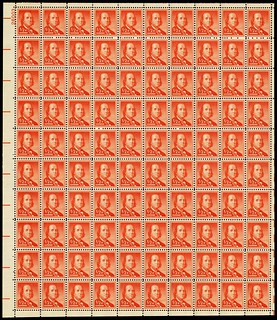 "I would like to disagree with Mr. Holabird concerning the state of philatelics. It is a
dying hobby. In Nashua, NH, there is a combined coin and stamp show held monthly. The stamp
dealers are all in their late 70's and beyond. Their customers are also, shall we say, elderly. I
have yet to see any young people buying stamps. Gummed, uncanceled stamps, in sheets,
commemoratives, with plate blocks from the 1940's and 1950's cost HALF face value. Later
stamps, plate blocks and otherwise uncanceled can be had for HALF face value. Even 1 and 2
cent stamps from the 1920's and 1930's are available at HALF face value as long as they are
uncanceled. Bottom line, most cancelled stamps, even old ones, have little value. Stamps prior
to 1920 may have value but no dealer was all that interested in them, even in an extensive
collection.
"I would like to disagree with Mr. Holabird concerning the state of philatelics. It is a
dying hobby. In Nashua, NH, there is a combined coin and stamp show held monthly. The stamp
dealers are all in their late 70's and beyond. Their customers are also, shall we say, elderly. I
have yet to see any young people buying stamps. Gummed, uncanceled stamps, in sheets,
commemoratives, with plate blocks from the 1940's and 1950's cost HALF face value. Later
stamps, plate blocks and otherwise uncanceled can be had for HALF face value. Even 1 and 2
cent stamps from the 1920's and 1930's are available at HALF face value as long as they are
uncanceled. Bottom line, most cancelled stamps, even old ones, have little value. Stamps prior
to 1920 may have value but no dealer was all that interested in them, even in an extensive
collection.
"I once bought some uncanceled stamps from a coin dealer at half face value. He remarked that "Stamps are like cockroaches, hard to get rid of." I regard uncanceled stamps as an interest free loan to the Post Office which comes due when I lick-'em and stick-'em."
NOTES FROM E-SYLUM READERS: MARCH 17, 2024
Chemistry on Coins
David Levy writes:
"I´ve got two very smart and charming daughters. They used to collect a few coins when I made them to join me in coin hunting through coin shops when they were just kids. They dont actively collect anymore but are fond of the few dozens of coins they gathered. One of them, Ana Carolina (aka Carol) decided to follow her dad´s footsteps and will apply for chemical engineering in a year. I was very surprised (positively!!) when I caught her examining one of her coins in particular - a 1976 Greece 10 drachmai (KM# 119; Numista 559) featuring an atom and Democritus (from Wikipedia: Democritus was an Ancient Greek pre-Socratic philosopher from Abdera, primarily remembered today for his formulation of an atomic theory of the universe).
"That kept me wondering, are there many other coins featuring chemical elements or chemistry concepts? I´m aware of a Tuvalu non-circulating coin featuring the periodic table and that's it. Any others? Perhaps with the help of this group young Carol would start a collection of her own and the world will get a new numismatist."
Great question. What other chemistry coins are out there? Has anyone already compiled such a list? -Editor
To read the complete Numista entry, see:
10 Drachmai old lettering
(https://en.numista.com/catalogue/pieces559.html)
Other topics this week include women currency dealers. -Editor
THE BOOK BAZARRE
SCOTT MILLER’S COIN CLUB BOOKLETS
Jeff Burke submitted this piece inspired by a group of coin club publications. Thanks! -Editor
Jeff Burke
Scott Miller was kind enough to loan me some coin club literature at our February 2024 meeting of the New Jersey Numismatic Society. These booklets and pamphlets included examples from “The Chautauqua Coin, Stamp and Curio Club” (1946, ex F. Gordon Frost); “Albany Numismatic Society” (November 1943, ex F. Gordon Frost); “Ninetieth Anniversary Celebration 1860-1950 Boston Numismatic Society”; “Papers Presented At Meetings of the Brooklyn Coin Club” (1941); “Prospectus of the British Numismatic Society” (Second Edition, 1903); and “A History of the Royal Numismatic Society 1836-1986.”
VOCABULARY TERM: PEWTER
Here's another entry from Dick Johnson's Encyclopedia of Coin and Medal Terminology. -Editor
Pewter. A high tin content white metal alloy, usually very soft and infrequently used for striking medallic items. The finest pewter is alloyed with antimony or copper (sometimes alone, sometimes in combination), most pewter, however, is alloyed with lead. In numismatic literature any item described as pewter is suspect, its true composition may be any of several white metal alloys or pure tin! Thus items described as pewter may be tin, or tin items may be called pewter, it is difficult to ascertain any white metal alloy by inspection alone.
PETER MOUGEY (1842-1908)
E-Sylum Feature Writer and American Numismatic Biographies author Pete Smith submitted this article on Cincinnati collector Peter Mougey. Thanks! -Editor
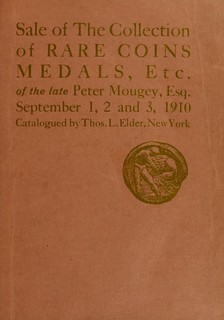 Peter Mougey was not well known as a coin collector. It was only after his death that the high
quality of his collection was revealed.
Peter Mougey was not well known as a coin collector. It was only after his death that the high
quality of his collection was revealed.
Pierre Nicolaus Mougey was born in Cincinnati, Ohio, on February 23, 1841, the son of Desire Mougey (1807-1879) and Felicite Clement Mougey (1815-1882). His parents came from France and were Ohio farmers. In numismatic references, his name only appears as Peter Mougey.
He was married in 1871 to Josephine Fieber (1848-1923) and had three sons and two daughters.
Mougey and his partner, F. M. Boyer were partners in Colter & Company wholesale grocers at Sixth and Main streets in Cincinnati. They acquired the firm after the 1880 death of founder Aaron A. Colter.
2023 CHICAGO COIN CLUB HALL OF FAME
The Chicago Coin Club has announced their Hall of Fame Inductees for 2023. -Editor
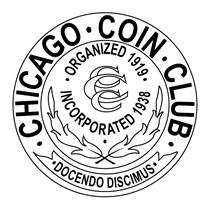 The Chicago Coin Club announced two new inductees to the clubs Hall of Fame at their December 2023
Banquet. The CCC Hall of Fame was created in 2019 to recognize a select group of prominent
numismatists that made significant contributions to numismatics on the local, state, regional and/or
national level. The original 12 inductees of 2019, one per month, were individuals who were no longer
living. Since then, Hall of Fame inductees have included living and/or deceased members.
The Chicago Coin Club announced two new inductees to the clubs Hall of Fame at their December 2023
Banquet. The CCC Hall of Fame was created in 2019 to recognize a select group of prominent
numismatists that made significant contributions to numismatics on the local, state, regional and/or
national level. The original 12 inductees of 2019, one per month, were individuals who were no longer
living. Since then, Hall of Fame inductees have included living and/or deceased members.
The 2023 class of Inductees are Mark A. Wieclaw and Professor R. Edward Davis (1878 – 1940)
Since 1919 the CHICAGO COIN CLUB has nurtured, educated and supported coin collectors of the greater Chicago and suburban areas. Celebrating over one hundred years of continuous monthly meetings the CHICAGO COIN CLUB lives by the motto Docendo Discimus “We Learn By Teaching”
WHAT KIND OF COLLECTOR ARE YOU?
In the February 2024 issue of Love Letter from the Love Token Society, Carol Bastable published an article titled "What Kind of Collector are You?" With permission, we're republishing it here. These themes are universal and likely apply to many of our readers. -Editor
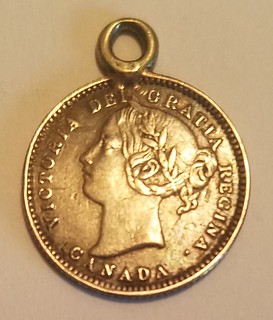 Have you ever wondered what drives one collector to collect one thing and another collector to pursue another thing? In the world of numismatics, collectors are greatly varied from coins to paper money and U.S. to ancient and foreign. Then there are the token and exomunia collectors. We fall into the exonumia field with love tokens. Yet even within our field, the options to collect are vast.
Have you ever wondered what drives one collector to collect one thing and another collector to pursue another thing? In the world of numismatics, collectors are greatly varied from coins to paper money and U.S. to ancient and foreign. Then there are the token and exomunia collectors. We fall into the exonumia field with love tokens. Yet even within our field, the options to collect are vast.
You collect what Strikes You: You do not have a specific plan or direction in your collecting. You are not building on any direction to your collecting or checking anything off of a list when you make a purchase. In fact, you probably do not have a formal want list. You are governed by what jumps out at you and grabs your attention. Often this is how many collectors start out. After being immersed in collecting for some time, you may hone your interests more.
You collect for reasons of Sentiment: You are collecting love tokens that remind you of people or things in your life. You may have assembled a family tree of initialed love tokens representing your family or you may purchase initialed love tokens and names for gifts, pairing the love token to the person. You may have a cat or dog so you want love tokens with those designs. I did a lot of roller skating in my teens and twenties. I even met my husband (now divorced) at the roller skating rink. Roller skating was a big part of my life. When I moved from the north to Florida, the roller rink was where I went to meet new friends. It would be no surprise that I have a love token (1883 Seated dime) with a roller skate on it.
NUMISMAGRAM MEDAL SELECTIONS: MARCH 17, 2024
Numismagram's Jeremy Bostwick sent these three items from his most recent upload of new material to his site. This upload, occuring on the Ides of March, had a very macabre theme. For all of the new items, please visit https://www.numismagram.com/inventory. -Editor
102056 | GERMANY. Nürnberg. Copper Rechenpfennig Issued circa 1580-1610. (27mm, 5.43 g, 12h). By H. Laufer. DEN KVMPT DER DODT GIBT DEN LON, skeleton standing left within a graveyard and wielding a spear; in background, church to right // ARBEIT VND TVGENT MACHT EDEL, infant Christ standing slightly left, raising hand in benediction and holding orb. Neumann 32331; "Aspects of Death and Correlated Aspects of Life in Art, Epigram, and Poetry," p. 567. Choice Very Fine. Tan-brown surfaces, with a lighter nature on the higher points. A very rare and haunting type, and the first of the type that we have seen. $695.
Rechenpfennigen, German for "accounting pennies," are similar to other tokens or jetons that could serve reckoning, gaming, or even semi-numismatic functions. In particular, the rechenpfennigen were made famous by their various manufacturers in Nürnberg (Nuremberg) from the mid-late 16th century to the early 18th century, with a host of themes used as subject matter. These topics included history, mythology, contemporary political affairs, and even satire. Though many were intended as aids in accounting and bookkeeping (with an accounting board and these tokens taking the place of an abacus or sliderule), they were also useful in other functions, such as in the world of gaming—as poker chips—or in commerce and monetary transactions—as a substitute for harder currency.
To read the complete item description, see:
102056 | GERMANY. Nürnberg. Copper Rechenpfennig
(https://www.numismagram.com/product-page/102056)
VILA RICA MOEDAS AUCTION 20
Vila Rica Moedas of São Paulo, Brazil will hold their next auction this week. Here's the announcement. Nice coins. For bibliophiles, there is a section of numismatic literature. -Editor
Vila Rica will hold its Auction 20 on March 19th and 20th. The auction is internet-only and split over two sessions. It will offer a vast range of Brazilian coins, from Colonial to Republican issues, and rare Literature, featuring:
-
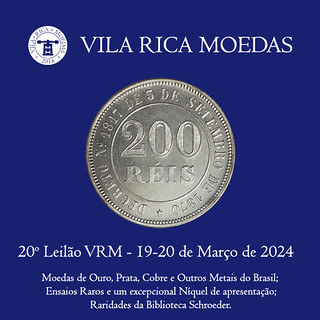 A selection of gold coins; among them we highlight the 1000 Réis 1726MMMM in exceptional condition, 1600 Réis 1767B UNC and 800 Réis 1728/7 M also in exceptional condition;
A selection of gold coins; among them we highlight the 1000 Réis 1726MMMM in exceptional condition, 1600 Réis 1767B UNC and 800 Réis 1728/7 M also in exceptional condition;
- Among the Silver coins, highlights include the rare 160 Réis 1813R with inverted reverse and 1821B with Bahia reverse (much rarer than the one with Rio reverse); 640 Réis 1822R, 2000 Réis 1863 very rare with inclined reverse;
- 200 Réis 1871 NGC MS64* featuring Proof Like surfaces - a piece with exceptional coinage quality produced with technology not available at the Brazilian Mint at the time. Possibly a presentation piece and as such extremely rare. Ask for the video so you can see how extraordinary the quality of this piece is;
- A very rare 10000 Réis 1840 assay in silver. Dom Pedro II Admiral on the obverse and the unapproved reverse with the monogram and imperial crown. The piece retains all of its original luster;
- We bring you some more rarities from the Cláudio Schroeder Library, including the famous Brazilian Gold Bars - Guilherme Guinle Collection, 1949. A very rare numismatic publication, this being from the Kurt Prober collection, with his notes reviewing, reclassifying, and correcting technical errors in the descriptions. The lot is accompanied by a set of letters between Guinle and Prober;
- Among the copper coins, two X Réis PPPP from 1694 and 1697 stand out, and an incredible set of 37 1/2 Réis de Minas from the Empire.
DAVISSONS AUCTION 43 SCOTLAND HIGHLIGHTS
Allan Davisson wrote this overview of the Leland Scott Collection of the Coins of Scotland in his firm's Auction 43, which closes on Wednesday, March 20th 2024. -Editor
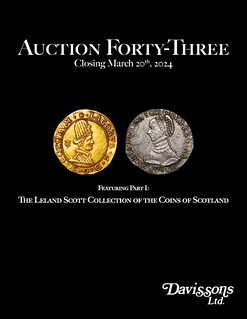 The Leland Scott Collection of the Coins of Scotland presents the first high quality, well-pedigreed collection of Scottish coins to come to the market since the LaRiviere sale in 2006. It anchors our 2024 major annual sale of some of the best coins we have come across in the past year.
The Leland Scott Collection of the Coins of Scotland presents the first high quality, well-pedigreed collection of Scottish coins to come to the market since the LaRiviere sale in 2006. It anchors our 2024 major annual sale of some of the best coins we have come across in the past year.
This beautiful and historic series contains a fascinating array of designs that chronicle the tumultuous winds of Scottish history, and presents a major departure in style and beauty from both the English and Irish coinage series.
NOTES ON SCOTTISH COIN DESIGN
Here's Allan Davisson's article on Scottish coin design. Davisson's Auction 43 of the Leland Scott Collection of the Coins of Scotland closes this week. -Editor
A few notes on Scottish coin design from David to Mary
Scottish coinage began during the Anarchy and Stephen’s reign (1135-1154). After the death of Henry I in 1135, Stephen of Blois, despite an oath to Matilda, Henry I’s daughter, seized the English throne. The next year, David I moved south to support Matilda, his niece. Capturing the mint at Carlisle resulted in the first coinage that is considered “Scottish.” Malcolm, David’s twelve-year-old grandson came to the throne in 1153 but coinage continued in the somewhat irregular pattern that had marked David’s reign, not unlike the irregular coinage of the Anarchy in England.
KUENKER AUCTIONS 403-405
Here's the first part of two parts of the press release with a preview of the Künker Spring Auction Sales 403-406. -Editor
Popes, Mainz, Regensburg and Löwenstein: Special Collections at Künker
Once again, Künker presents numerous special collections at their Spring Auction Sales. You can look forward to papal coins and medals, issues of the Mainz mint, Regensburg as well as Löwenstein-Wertheim. Moreover, a plethora of world coins and medals is on offer with a focal point on German issues.
As many as four catalogs with coins and medals from medieval and modern times alone will be presented in Künker’s Spring Auction Sales, taking place from 18 to 22 March 2024 in Osnabrück. Auction 403 contains papal coins and medals from the estate of a south-west German entrepreneur; auction 404 offers the second part of Mainz coins and medals from the Prof. Dr. Eckhart Pick Collection; auction 405 deals with an important special collection of coins from the bishopric and the imperial city of Regensburg; and general catalog 406 does not only include world coins and medals but also a special collection with issues of the counts and princes of Löwenstein-Wertheim. Moreover, an extensive selection of Habsburg talers and ducats is on offer.
In short: 3,240 lots with a total estimate of 4.3m euros eagerly await their new owners. There really is something on offer for everyone. Estimates start in the low two-digit range, although this preview will obviously focus on the more expensive pieces. Look forward to a rich offer of exquisite world issues!
KUENKER AUCTION 406
Here's the second and final part of the press release with a preview of the Künker Spring Auction Sales 403-406. -Editor
Auction 406: Issues from Medieval and Modern Times
More than 1,800 lots with coins and medals from medieval and modern times are offered at Künker’s auction 406. No matter what you are interested in, browsing through this catalog is a must. Be it world coins, medieval rarities, issues from the German States, the German Empire, ducats or talers. This catalog contains countless interesting offers, including several special collections.
No. 3524: France. Philippe VI, 1328-1350. Ange d’or n.d. (1341). Very rare. About extremely fine. Estimate: 15,000 euros
STACKS BOWERS OFFERS NINI TERRACOTTA PORTRAITS
The Richard Margolis collection of Terracotta Portrait Medallions by Jean-Baptiste Nini will be offered by Stack's Bowers in their Spring 2024 Whitman Expo Auction. Here is a selection of highlights. Amazing material. -Editor
of Terracotta Portrait Medallions
by Jean-Baptiste Nini
In American numismatic auctions, Nini is well known for his 1777 and 1779 terracotta portrait medallions of Benjamin Franklin. Richard Margolis wrote an in-depth study of this small series titled Benjamin Franklin in Terra Cotta, published in 2015. Upon consignment, we anticipated a collection of the Franklin portraits, but were delighted to see that Margolis had collected Nini’s works more broadly. Including a nice selection of Franklin medallions, we will present more than two-dozen Nini profiles dating from the 1760s to 1785. As far as we are aware, this is the first presentation of this speciality in an American numismatic sale. A selection of highlights is featured here.
VANCOUVER ISLAND GLEN GREEN'S ORCA COIN
As noted before, local publications can be a good source of information about coin designers not found elsewhere. Here's an article about the artist behind the Royal Canadian Mint's new Orca coin. Nice design! -Editor
A new Royal Canadia Mint silver coin features the artwork of a Vancouver Island-based artist.
The coins, a part of the This is Canada collection, depict various species that can be found across the country. This year’s theme is Wondrous Waters and one of the collectable coins features a pod of orcas.
Created by artist Glen Green, the orcas are travelling in the water near a rocky island. Mint adds in the background that large forests and mountains line the shore.
REPLICA PINE TREE SHILLINGS AT CSNS
Pewter replicas of the Pine Tree Shilling will be struck at the upcoming Central States Numismatic Society convention. Here's the press release. -Editor
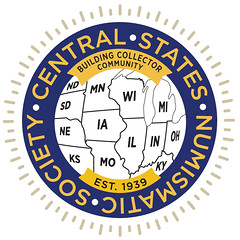 Visitors can see $100 million of historic money and buy and sell rare coins, paper money, and gold and silver bullion with hundreds of professional dealers from the Midwest and across the country at the Central States Numismatic Society convention, May 2-4, 2024. The annual show will again be held at the Renaissance Schaumburg Convention Center, 1551 North Thoreau Drive, in the Chicago suburb of Schaumburg, Illinois.
Visitors can see $100 million of historic money and buy and sell rare coins, paper money, and gold and silver bullion with hundreds of professional dealers from the Midwest and across the country at the Central States Numismatic Society convention, May 2-4, 2024. The annual show will again be held at the Renaissance Schaumburg Convention Center, 1551 North Thoreau Drive, in the Chicago suburb of Schaumburg, Illinois.
“At this year’s convention, you can watch souvenir replica coins struck on a hand-operated, century-old rolling mill press,” said Central States President Mitch Ernst.
Specially crafted pewter replicas of the 1652-dated Pine Tree Shilling, one of Colonial America’s most famous rare coins, will be struck during the convention and available for $1 each while supplies last. A limited number also will be struck in .999 fine silver by engraver Joe Paonessa of The Root River Mint in Racine, Wisconsin with their price based in connection with the spot price of the precious metal.
2024 ANIMALS IN WAR & PEACE CEREMONY
Here's the post-event press release for the 2024 Animals in War & Peace Ceremony at the U.S. Capitol. -Editor
Honored Seven Remarkable Canine Heroes
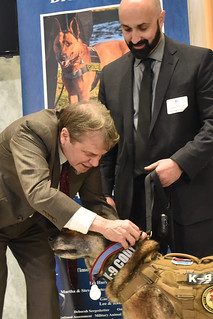 Distinguished Members of Congress participated in the recent Fourth Annual Animals in War & Peace Ceremony to celebrate seven extraordinary canine heroes in recognition of their courage and sacrifice to the United States and their significant contributions in both times of war and peace.
Distinguished Members of Congress participated in the recent Fourth Annual Animals in War & Peace Ceremony to celebrate seven extraordinary canine heroes in recognition of their courage and sacrifice to the United States and their significant contributions in both times of war and peace.
The Animals in War & Peace Medal of Bravery recognizes animals that have served in past conflicts and current working or retired military canines representing various branches of U.S. military services, service animals, and First Responders. The 2024 Animals in War & Peace Medal of Bravery recipients:
CRANE MUSEUM PAUSES LOCATION SEARCH
Changes in security on the company campus led to the closure the Crane Museum of Papermaking. After searching two years for a suitable alternate location, the museum is shifting to a pop-up model for the time being. -Editor
The Crane Museum of Papermaking has indefinitely paused its search for a permanent location and shifted its focus to a pop-up museum model.
The nonprofit organization searched for a location for two years but was unable to find one it liked. However, a successful pop-up museum last summer at Arrowhead got its leaders rethinking its operations.
It is currently unclear if it will reignite the search in the future, but at the moment, the museum's Director Jenna Ware is focusing on the summer season, educational programming, community events, and collaborating with other organizations in the area.
LOOSE CHANGE: MARCH 17, 2024
Here are some additional items in the media this week that may be of interest. -Editor
France's new circulating Euro coins will feature female national icons. -Editor
France is redesigning its 10, 20 and 50 euro cent coins to honour women who have marked the country's history. The faces of national icons Simone Veil, Josephine Baker and Marie Curie will appear on coins set to go into circulation from the middle of 2024.
The new coins were designed by the French mint's chief engraver Joaquin Jimenez and feature the "three exceptional women".
Their profiles face in the same direction as "The Sower", the stylised female figure representing liberty that has been seen on French coins for the last 120 years.
The French side of the one and two cent coins, which feature oak and olive branches within a hexagon, was last redesigned for the 20th anniversary of the euro in 2022.
Great choices. Baker was born into poverty in St. Louis and went on to become a celebrated French dancer, singer and actress. She spoke at the 1963 March on Washington at the side of Martin Luther King Jr. "I have walked into the palaces of kings and queens, and into the houses of presidents and much more. But I could not walk into a hotel in America and get a cup of coffee, and that made me mad."
For another numismatic connection, Baker was awarded a number of medals in her long career. What were some of them, and where are those medals today? -Editor
To read the complete article, see:
Veil, Baker and Curie: acclaimed women to appear on new French coins
(https://www.rfi.fr/en/france/20240310-veil-baker-and-curie-acclaimed-women-to-appear-on-new-french-coins)
Other topics this week include a Football Referee's Medals, and the Lindbergh Baby kidnspping ransom notes. -Editor


